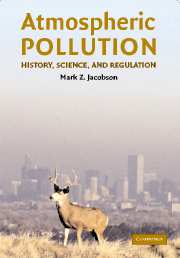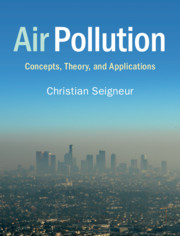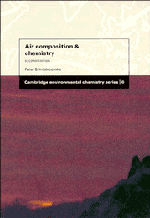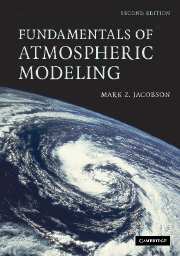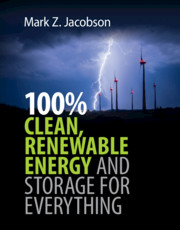Air Pollution and Global Warming
This new edition of Mark Z. Jacobson's textbook provides a comprehensive introduction to the history and science of the major air pollution and climate problems that face the world today, as well as the energy and policy solutions to those problems. Every chapter has been brought completely up to date with new data, figures and text. There is a new additional chapter on large-scale solutions to climate and air pollution problems. Many more color photographs and diagrams, and many additional examples and homework problems have been added. This is an ideal introductory textbook on air pollution for students taking courses in atmospheric chemistry and physics, meteorology, environmental science, Earth science, civil and environmental engineering, chemistry, environmental law and politics, and city planning and regulation. It will also form a valuable reference text for researchers and an introduction to the subject for general audiences.
- Provides a comprehensive introduction to the science, policy and history of air pollution
- Offers an excellent balance of science, regulation and history
- Illustrated in full color
- The second edition has been brought fully up to date, including coverage of global warming
Reviews & endorsements
'An excellent textbook to introduce students with a basic scientific background to some of the most imminent issues of our time - air pollution and global warming … This new edition improves upon its popular predecessor.' Daniel A. Knopf, State University of New York, Stony Brook
'… the second edition has been thoughtfully updated to reflect the latest trends and research in the fields of air pollution and climate change.' Derek J. Straub, Susquehanna University
'… a unique integrated introduction to atmospheric science, the science and adverse impacts of air pollution and climate change, and the regulations that address them.' Denise L. Mauzerall, Princeton University
'… an excellent overview of many facets of air pollution and global warming science. It's an excellent reference for students and professionals.' Jonathan D. W. Kahl, University of Wisconsin, Milwaukee
'This engaging and comprehensive book is effectively designed to introduce students to the chemistry and physics of Earth's atmosphere, and to pressing environmental change topics such as urban air pollution. Air Pollution and Global Warming is exceptionally well-written and presented. This is an ideal text to introduce students to the chemistry and physics of Earth's atmosphere. This accessible textbook provides a practical understanding of chemistry and physics applied to atmospheric science topics, and to the nature, causes and consequences of human modification of the atmosphere.' Sara Pryor, Provosts Professor of Atmospheric Science, Indiana University
Praise for the first edition: '… one of the standard texts in this field, especially for environmental science courses at undergraduate and postgraduate level, as well as a general reference and sourcebook for anybody interested in the history of airborne pollutants and their study, pollution meteorologists and atmospheric chemists.' Weather
Praise for the first edition: '… highly valued in environmental science curricula for its integrated approach to the scientific dimensions of all aspects of the atmospheric environment …' Chemical Heritage
Praise for the first edition: '… well suited for individuals or courses with an interest in the history of air pollution science and regulation.' EOS, Transactions, American Geophysical Union
Praise for the first edition: '… a well-rounded introduction to problems of the atmosphere and offers rich material for students contemplating their solutions …' Physics Today
'… [this] rigorous book brings a refreshing, optimistic perspective which contrasts with so many of the already available publications in this field. Its grounds are clearly rooted in science, data, statistics, existing reports and new initiatives … delivers all the promises announced in its title; it remains an important and exceptional book in this vast array of scientific documentation related to environmental science.' Yves Laberge, Electronic Green Journal
Product details
June 2012Paperback
9781107691155
406 pages
254 × 204 × 18 mm
0.97kg
238 colour illus. 71 tables
Temporarily unavailable - available from April 2025
Table of Contents
- 1. Basics and discovery of atmospheric chemicals
- 2. The sun, the Earth, and the evolution of the Earth's atmosphere
- 3. Structure and composition of the present-day atmosphere
- 4. Urban air pollution
- 5. Aerosol particles in the polluted and global atmosphere
- 6. Effects of meteorology on air pollution
- 7. Effects of pollution on visibility, UV radiation, and colors in the sky
- 8. International regulation of urban smog since the 1940s
- 9. Indoor air pollution
- 10. Acid deposition
- 11. Global stratospheric ozone reduction
- 12. The greenhouse effect and global warming
- 13. Energy solutions to air pollution and global warming.


